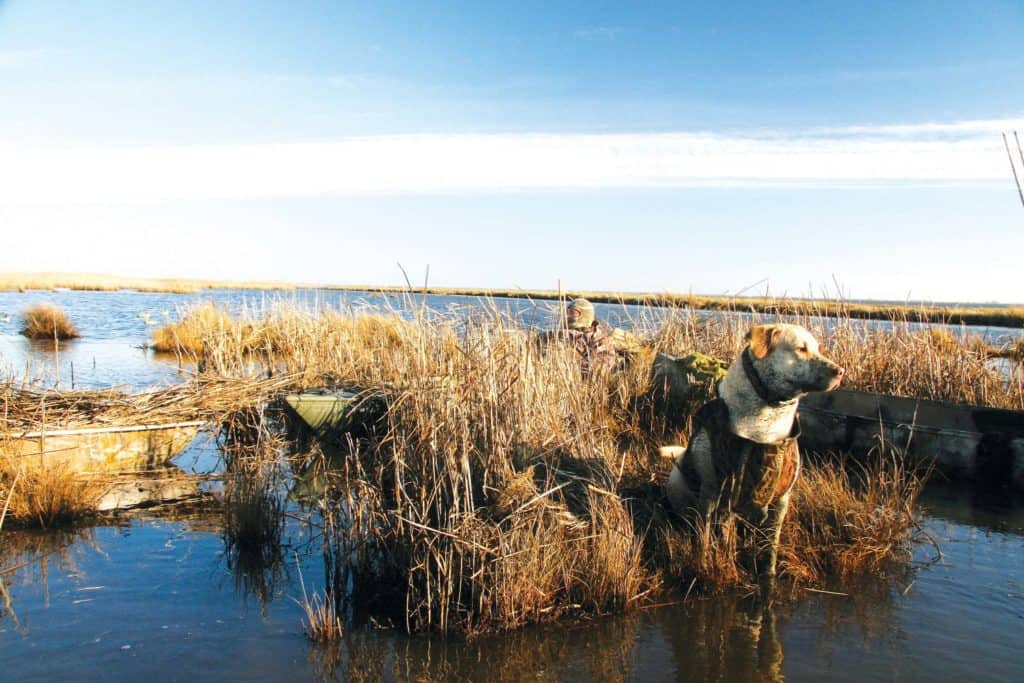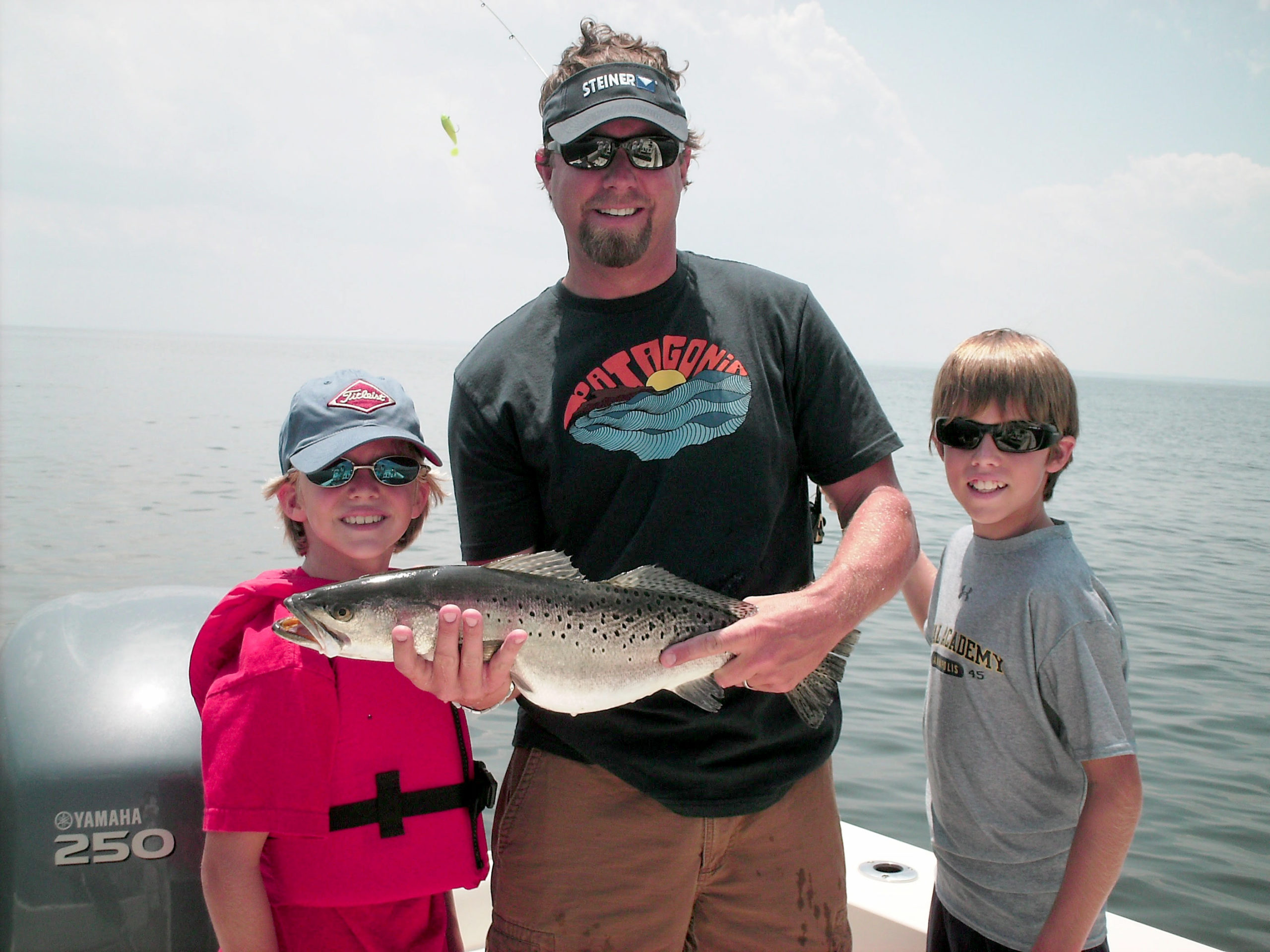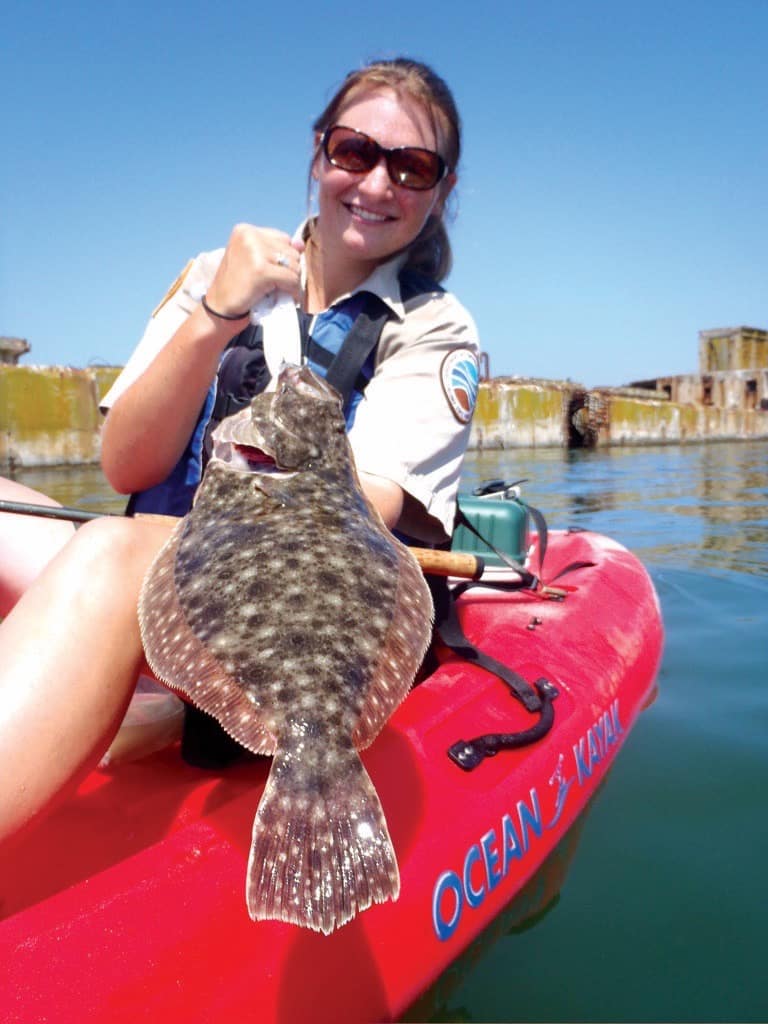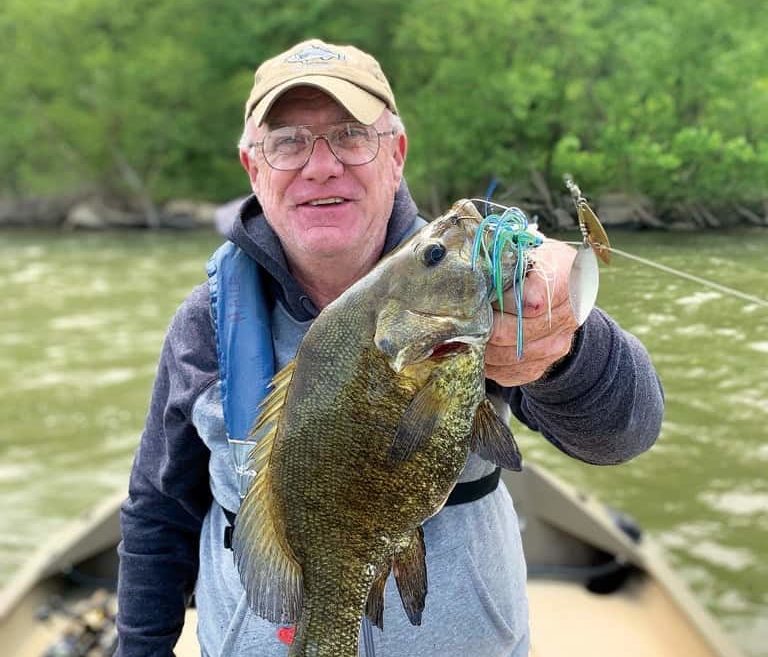Inside the Chessie Relationship
I didn’t mean to laugh out loud when my editor insisted, “Well, you know Chesapeakes so you’re the guy to write about them.” I chuckled because I wondered if anyone truly knows what goes on inside the head of a Chesapeake Bay Retriever.
I’ve been a hunting partner to two Chessies over the past twenty years—the first, a crazy-curly brown male named Huckleberry and my current dog, ten-year-old Merle who sports a dead-grass blonde coat. They could not be any different in personality. Huck was as sweet as pie, and Merle, well, the fact he’s named for Merle Haggard and Merle Watson, dual personalities, so to speak, tells you all you need to know. Both dogs shared unparalleled drive and loyalty, and that’s what makes a Chessie a Chessie.
Once, after a day’s hunting in the lower Bay’s marshes, an old salt eyed Merle in the pickup bed, and remarked, “Best way to train a Chesapeake is with a two-by-four.” I wanted so badly to retort that maybe he’s the one in need of a wood shampoo. Instead, I politely replied that that tactic is outdated, and it doesn’t really work. In my experience, hunting with a Chessie, is all about winning the contest of wills and effective negotiation.
The story of how the breed came to the Chesapeake is a good one, a truly American tale replete with a sea rescue, laced with mythology and meandering life paths leading to what is arguably the hardest working water gun dog. The breed’s lineage is undoubtedly linked to Newfoundland canines. Their love of water attests to that. Chessies can be traced back to 1807 when two puppies were rescued by the crew of the Baltimore-based sailing vessel Canton that came upon a British brig bound for Liverpool foundering off Newfoundland. The female was named for the vessel, and reportedly was given to Dr. James Stuart of Sparrows Point. The reddish male came to be called Sailor and was taken by John Mercer of West River, Maryland. After that, as many American myths do, things get a bit colorful and slightly murky. Once settled in Maryland, it’s unclear if the pair was bred with each other or other hunting breeds. One variation has Sailor and Canton mated with English water poodles; another to yellow and tan coonhounds, and a third even supposes they were crossbred with otterhounds, or possibly flat- and curly-coated retrievers. Some say the more likely scenario is they were paired with canines native to the Bay region. Whatever the truth, it is undeniable this mingling of dog stocks produced an exceptional retrieving dog.
What is also certain is that, beginning in the mid-1800s, Chesapeake watermen, farmers and sportsmen all played a role in developing the Chesapeake Bay Retriever we know today. Chessies guarded the Bay bounty gleaned by market gunners and oystermen alike, as well as protected the homestead. By the end of the 19th century, waterfowl hunting for sport was taking hold in earnest along the Atlantic seaboard and inland to the Midwest, and as it did, gunners appreciated the Chessies’ exceptional skills, stamina and willingness to retrieve ducks and geese in the most frigid of waters without fail.
Here’s what renowned dog trainer and field judge Bernard Waters wrote in his 1895 treatise on training retrievers—“The Chesapeake Bay dog is remarkably intelligent and physically of extraordinary bone and muscle, and they are said to be indefatigable in work, and persistent in fetching to bag the most difficult birds.” C. John Sullivan, Jr., in his book, Chesapeake Bay Retrievers, Decoys & Long Guns: Tales of Carroll’s Island Ducking Club, notes the dogs became famous for their drive to “retrieve fowl, loyalty and intelligence. That independent streak is a hallmark of the breed.”
I’ve hunted the same area Sullivan, Jr. writes of, as a guest of Jim and Kevin Colbeck. On Saltpeter Creek, we hunted over Kevin’s stalwart Chessie, Tarman, who did his ancesters proud when he smashed through one-inch thick ice to retrieve a felled bird. It was a phenomenal experience, watching the dog’s unrelenting energy and drive. To him, however, it was just another day at the office. I’ll add that anyone considering getting a Chesapeake and not hunting is risking a bad experience and doing a disservice to himself and the dog. These dogs need to hunt.
The winter of 2012-13 was the first time in 12 years that I hunted waterfowl without Huck. He’d passed away in May. Of all the adventures we shared, two come to mind. The first happened in January 2003, as a northwest wind roared down Tangier Sound, pummeling the waters into an angry froth. My young Chessie and I took refuge in the lee of a marsh atoll in the Cedar Island Wildlife Management Area in Somerset County. We weathered the gale, tucked up against the cordgrass like egrets. Like us, the ducks sought respite from the blow, and a trio of widgeons lit to our decoy spread. I shot three times, one bird fell and was immediately carried away by the wind and waves toward Saxis Island. Ever eager to please, and before I could command him not to break, Huck dove into the icy water and swam for the bird. Sensing the danger, the duck found new life and dove as Huck closed the gap. Huck put his head underwater to scan each time the duck dove. A very unsettling scene unfolded as I watched, shore-bound and on the verge of panic.
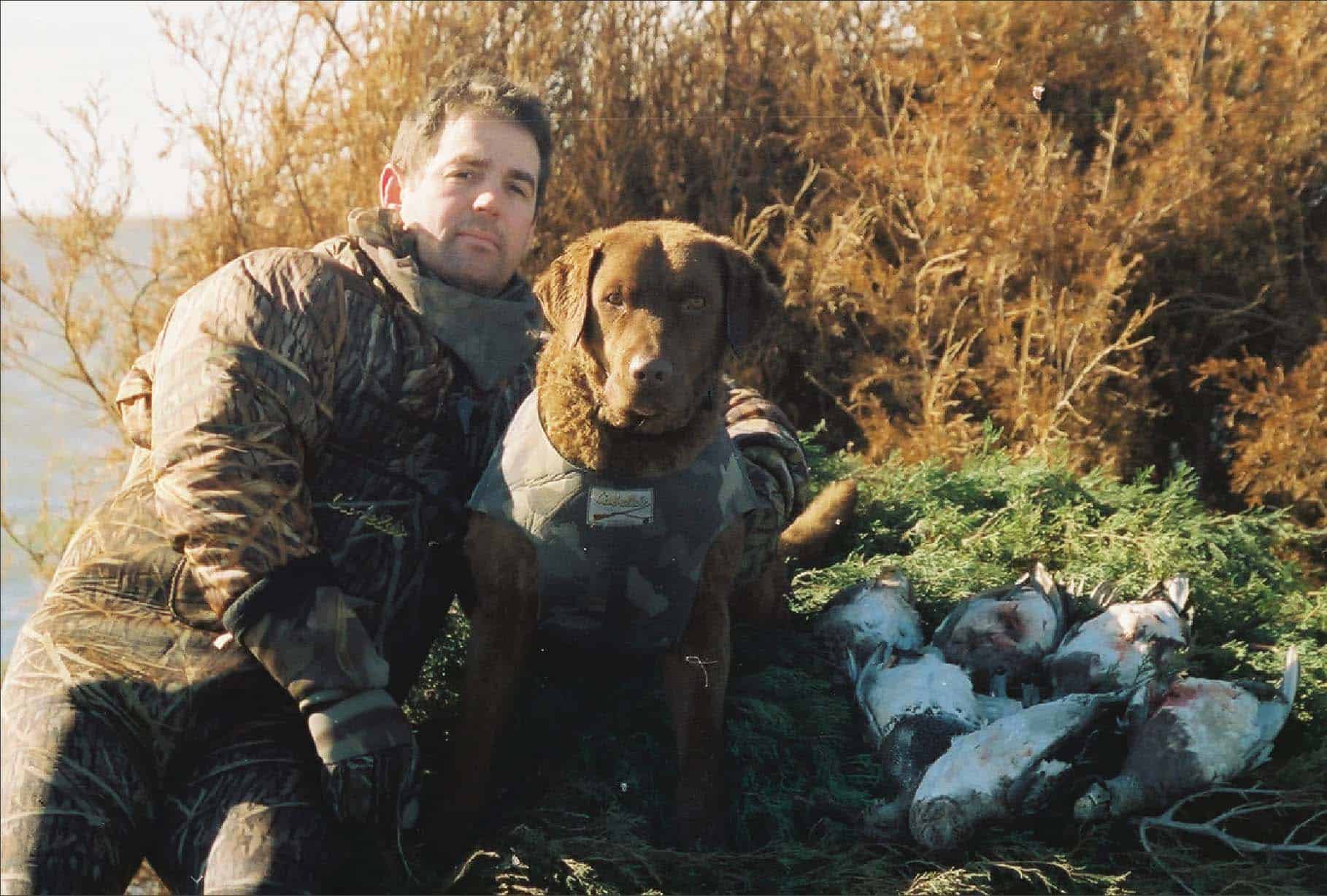
Chris Dollar and Huck. Photo by Kevin P. Colbeck.
As this rough-water wack-a-mole played out for what seemed like an hour, I sprinted for the skiff hidden among the cordgrass. I shoved the boat into water deep enough to run the engine and spun around to witness the duck popping up a final time and into Huck’s waiting maw. I met him half-way out as he worked his way to shore. Exhausted, we sat for a long spell on the sod bank. I rubbed the nape of his neck, grateful he was safe, and heaped praise upon him for his determination. The dog gave me a look that could have said, “No sweat, buddy, I had it under control.”
The second tale occurred while camping along a trout stream in the Shenandoah Valley. A game warden emerged from the verdant spring foliage, startling us. Huck barked, as dogs have done for thousands of years to alert their companions of someone or something approaching camp. Without announcing himself, the officer drew his service revolver, pointed it at us, and screeched, “Get your dog under control!” With one hand up, I cautiously stepped in front of the dog, grabbed Huck’s collar with the other hand while imploring the young man with the gun to “go easy.” The dog slid beside me, not aggressively but also holding his ground. My protector. I repeated as calmly as I could, “Go easy. Don’t shoot.” The surreal standoff lasted all of 20 seconds, but time stood still.
When things calmed down, I showed the officer my license and camping permit. True to his nature, Huck had forgotten about the tense standoff, and even tried to extend a “no hard feelings, fella. Like you, I’m just doing my job” via the famous Chessie smile and otter-like tail-wag. The overzealous lawman ignored Huck’s attempt at a handshake, wrote me up on some specious citation, and moved off. In doing so he cemented the facts that he was no dog man, and he was a shaky wildlife officer.
A year later, the day came when I watched him struggle to turn around in the sticky mud while searching for a downed pintail. I knew then it was time to retire him. As a duck dog, he was above average and dependable. As a friend and companion his worth remains incalculable. He loved me unconditionally and loved to be with me. I feel the same about him.
One of the universal injustices is the woefully short lifespan of dogs. They simply aren’t with us as long as they should be. That’s especially true of Chessies. But I’m biased. In my home office hangs a tattered Peanuts comic strip in which Linus and Charlie Brown are sitting on a dock, looking up at the stars and contemplating the universe. Linus paraphrases Carl Sagan’s perspective of the immensity of our solar system, to which Charlie Brown simply responds, “I miss my dog.”

